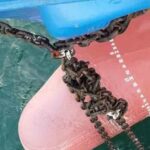Real Life Accident: Sloppy Navigation Leads To Bottom Contact And Damage
During daylight hours, a small general cargo vessel was en route for discharging in good weather and visibility. The vessel (and crew) had often taken this same route but on this day, with the Master’s consent, they deviated from the original track as described in the voyage plan in order to save time.
However, the voyage plan was not updated at the time and the Master and officers improvised based on local knowledge. Additionally, the officers did not bother to erase the old course lines, resulting in many confusing lines on the chart. At the watch handover the deviation from the original track was discussed and the relieving officer had no problems with this deviation. The new track would lead the vessel north of a wind farm and also north of some shallows.
A little later the OOW had to alter course to starboard due to an approaching vessel. The vessel then met a number of vessels under sail so the OOW again altered to starboard. Since he was navigating principally by visual means the OOW did not appreciate how close the vessel was coming to the shallows on its starboard side. He was aware of the existence of the shallows, now straight ahead, but he had the impression that he would pass their outer limits with a charted depth of about 10.0 metres.

The OOW also knew about squat, but he assumed that an under keel clearance (UKC) of 0.7 metres would be enough to pass the shallowest part without a problem. Unfortunately, as they passed over the shallows the vessel touched the bottom twice. The vessel had to enter dry dock for repairs; there was paint damage and some scratches up to frame 88. Tank number 4 was taking water and there was damage to the propeller blades. Some cracks were also found in the rudder.
Lessons learned
- By deviating from the original course the vessel was brought into a potentially busier area where more yachts and pleasure craft could be expected.
- It is better to navigate by instruments, even in fine weather, than by ‘impressions’.
- By reducing speed, the time available to take action would be increased, the CPA with the nearest sailing boat could have been increased and the squat would have been reduced. Unfortunately, the OOW did not avail himself of this option.
- Always use a chart which is in a good and updated condition. Old and non-used course lines must be erased.
- Trying to find short cuts in order to save (some) time is not a valid argument. The primary concern must always be the safe navigation of the vessel.
- If an ad hoc deviation is made, the voyage plan should be adjusted accordingly.
Reference: nautinst.org
Do you have info to share with us ? Suggest a correction
- Real Life Incident: Vessel Collision in Good Visibility
- Real Life Incident: Severe Injury To Deck Crew While Leaving Berth
- Real Life Incident: Departure Damage in Very Restricted Waterway
- Real Life Incident: Low Situational Awareness Has High Impact Consequence
- Real Life Incident: Fouled Anchor in a Designated Anchorage
- Real Life Incident: Fire On Barge Carrying Scrap Metal Causes $7 Million Worth Of Damage
Latest Case studies Articles You Would Like:
Subscribe To Our Newsletters
By subscribing, you agree to our Privacy Policy and may receive occasional deal communications; you can unsubscribe anytime.
















Many incidents and many more near misses happen due to similar sloppy navigation.
At times its over-confidence or careless approach or incompetence or pressure or a mix of them which gives rise to such incidents. These incidents are easily avoidable if one follows the basics of being alert and putting safety of navigation as top priority.
Essence of safe navigation , as referred in ROR too, is ALLERTNESS AND CAUTION ; that , modern young seafarer thinks are obsolete and are replaced by modern equipment and technics.
No advancement in knowledge of electronics , technology and management systems can replace these basics , they are at best AIDs to safe navigation with “alert and cautious” brain operating them. Basics of seamanship n navigation cannot be ignored , bypassed or superseded.
Good information but I think Have some instructions for duty officer in case bad weather if u can add somethings for bad visibility
Thx
*shallow areas large vessels can hit singapore etc, thus reduce the speed accordingly